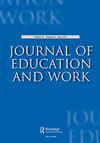Predicting stable employment trajectories among young people with disabilities
IF 1.7
Q2 EDUCATION & EDUCATIONAL RESEARCH
引用次数: 0
Abstract
ABSTRACT Research aiming to explain disabled people’s inequalities in the labour market has primarily focused on transitional factors between school and work, wage gaps, or socioeconomic background characteristics as explanations for (no-)entry in the labour market. There is a lack of longitudinal studies that map how disabled people fare in the labour market over time. Therefore, the objective of this paper is to identify, describe and predict stable employment paths of long-term disabled people. Our study employs detailed longitudinal data with total coverage of the Norwegian population – we focus on 11 birth cohorts (1973–83) of disabled individuals and we follow their employment trajectories between the ages 20 and 34. To describe employment trajectories and create a typology of longitudinal labour market attachments, we employ sequence analysis and subsequently linear probability models to analyse the association between the disability’s severity, gender, educational enrolment, early-work experience and employment trajectories. We identify four main types of trajectories: permanently work-disabled, stable employment, early marginalisation, and unstable employment. Our findings indicate that men are more likely than women to have stable employment trajectories. Starting higher education, as well as parental higher education, is linked with the likelihood of stable employment.预测残疾青年的稳定就业轨迹
旨在解释残疾人在劳动力市场中的不平等的研究主要集中在学校和工作之间的过渡因素,工资差距或社会经济背景特征作为解释(未)进入劳动力市场的原因。对于残疾人在劳动力市场上的长期表现,目前缺乏纵向研究。因此,本文的目的是识别、描述和预测长期残疾人的稳定就业路径。我们的研究采用了详细的纵向数据,覆盖了挪威人口的全部范围——我们重点关注了11个出生队列(1973-83)的残疾人,我们跟踪了他们在20至34岁之间的就业轨迹。为了描述就业轨迹并创建纵向劳动力市场依恋的类型学,我们采用序列分析和随后的线性概率模型来分析残疾严重程度、性别、教育入学率、早期工作经历和就业轨迹之间的关系。我们确定了四种主要类型的轨迹:永久工作残疾、稳定就业、早期边缘化和不稳定就业。我们的研究结果表明,男性比女性更有可能拥有稳定的就业轨迹。开始接受高等教育,以及父母接受高等教育,与稳定就业的可能性有关。
本文章由计算机程序翻译,如有差异,请以英文原文为准。
求助全文
约1分钟内获得全文
求助全文
来源期刊

Journal of Education and Work
EDUCATION & EDUCATIONAL RESEARCH-
CiteScore
2.70
自引率
14.30%
发文量
40
期刊介绍:
The Journal of Education and Work is an international forum for academic research and policy analysis which focuses on the interplay of the education and economic systems. The journal examines how knowledge, skills, values and attitudes both about and for work and employment are developed within the education system. The journal also explores the various forms of industrial training and accreditation in the economic system, including changes in the economic and industrial infrastructure which influence the type of employees required. Work in the informal economy is also included.
 求助内容:
求助内容: 应助结果提醒方式:
应助结果提醒方式:


